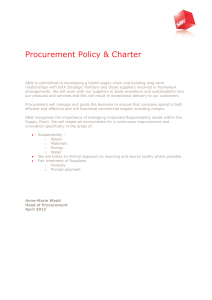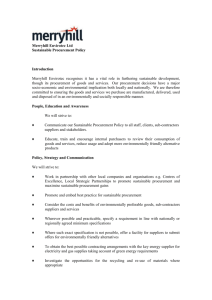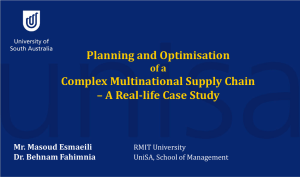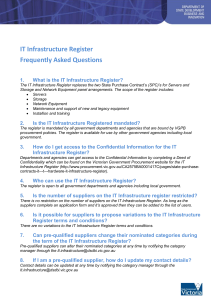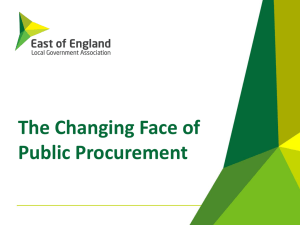Case Study:How the University of Manchester
advertisement
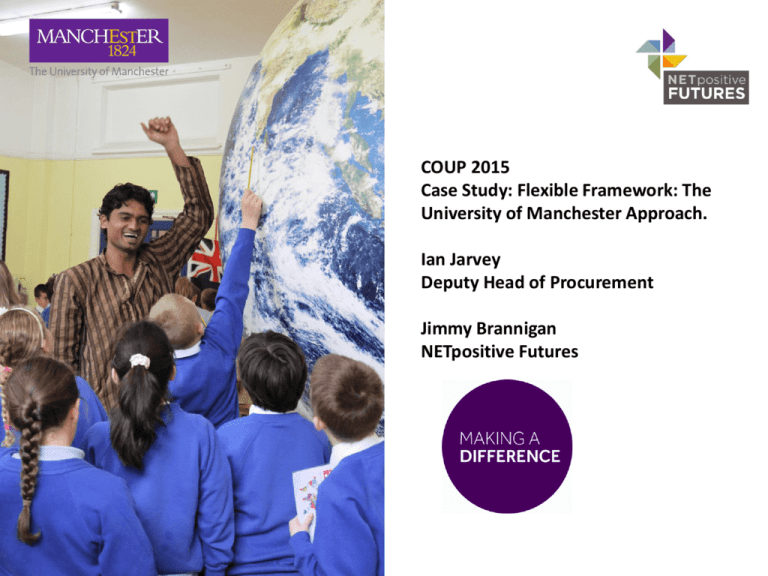
COUP 2015 Case Study: Flexible Framework: The University of Manchester Approach. Ian Jarvey Deputy Head of Procurement Jimmy Brannigan NETpositive Futures Overview • • • Context: • Background on the University of Manchester • Manchester’s Vision Our approach to the Flexible Framework A couple of quotes from a local boy Geoffrey Chaucer: ‘Time and tide wait for no man’ – GET ON WITH IT ‘People can die of mere imagination’ – IT ISN’T AS SCARY AS YOU THINK The University of Manchester University Estate: Investing £1BN 2020 Vision Goal 1 World Class Research: to be one of top 25 research universities in the world Goal 2 Outstanding learning and student experience Goal 3 Social Responsibility: Contribute to the social and economic success of the community What does Social Responsibility look like? ADDRESSING INEQUALITIES ETHICAL GRAND CHALLENGES SCHOOLS GOVERNORS INITIATIVE CULTURAL ACCESS PROGRAMME THE WORKS STAFF STEPS TO SUSTAINABILITY Strategic Priorities Signature Programmes Key drivers for responsible procurement at the University of Manchester are: • To take a meaningful lead as the largest UK university • To support our commitment to Social Responsibility and Environmental Sustainability • To strive to have a positive impact through our spend – by reducing negative impacts and enhancing positive impacts Where did we start? Refresher: Flexible Framework People Foundation Level 1 Embed Level 2 Practice Level 3 Enhance Level 4 Lead Level 5 • • • • • • • • Champion Basic training Induction • Purchasing Staff trained Key staff advanced training • Refresher training Performance objectives Incentives • Competences and selection Embed in induction • • Policy, Strategy & Communication Procurement Process • • • Objectives agreed Simple policy Endorsed by CEO & communicated • • Spend analysis and impacts Key contracts reviewed and awarded VFM • • • • • Review policy and supplier links Wider strategy Communication • Detailed spend analysis and prioritisation Consideration early & WLC • • • Widen strategy to review risk etc. Endorsed by CEO • All contracts reviewed and full risk approach Key suppliers targeted • • • Enhance strategy & new technologies Link to EMS etc. • Detailed high risk contract review Contract governance cycle & life cycle cost • • • • Engaging Suppliers • • Measurement & Results • Key supplier spend/impact known Key suppliers engaged Key impacts of procurement activity identified • • • • Detailed spend analysis General programme supplier engagement with senior support Detailed appraisal of impacts undertaken Measures implemented to manage high risks • • • • Targeted improvement programme Two way communication Supply chain mapping • Sustainability measure refined from general measures and linked to objectives • • • • • Intensive development key suppliers Audits and improvement plans recorded CEO involved • Integrated into balanced score card Comparison with peers Benefit statements • • • • • • Publicity to attract staff Internal/external recognition Share practice Regular review and linked EMS etc. Communication and publicity Life cycle commodity approach Targets agreed with supplier Best practice shared Suppliers key role in delivery CEO engages Best practice shared Suppliers recognise need to follow best practice to remain Measures drive organisational strategy Benchmarking Independent audits Team development at the core, plus: • • • • • • Governance and Strategic Commitments Materiality Analysis Risk and impact analysis Supplier Engagement Staff Support and Guidance Measurement and Reporting Governance and Strategic Commitments Materiality Analysis Environmental Priorities - Reducing carbon emissions - Reducing utilities consumption - Sustainable management of waste - Energy efficiency - Maximise resource efficiency - Increasing biodiversity on campus - Contributing to national and international understanding of environmental issues - Utilities management - Behaviour change Social Priorities - Supporting local communities - Supporting national and international communities - Community engagement - Improving sustainable travel practices - Staff wellbeing - Staff engagement Economic Priorities - Socially responsible investing - Sustainable procurement - Investment in public realm - Value for money - Whole-life costing - Exploiting in-house expertise Reducing carbon emissions Reducing utilities consumption Sustainable management of waste Energy efficiency Maximise resource efficiency Increasing biodiversity on campus Contributing to national and international understanding of environmental issues Utilities management Behaviour change Engaging suppliers on sustainability Video conferencing Sustainable travel options Reduce packaging End of life recyclability Recycled content Zero waste construction Energy use Whole life costing Environmental Deliveries per week Targets tracked against Strategy Supporting local communities Supporting national and international communities Community engagement Improving sustainable travel practices Staff wellbeing Staff engagement Meet the buyer events Supply chain Training on site Staff skills Local suppliers Local workforce apprentices Social Jobs created Targets tracked against Strategy Socially responsible investing Sustainable procurement Investment in public realm Value for money Whole-life costing Exploiting in-house expertise Living wage SMEs in subcontracts Economic Contracts let to local contractors Targets tracked against Strategy Risk and impact analysis • Detailed spend review – level 2 Proc-HE codes • Marrakesh risk review • Prioritise spend categories – high risk & spend • 2014 – 72 • 2015 - 63 • NETpositive analysis to identify a range of issues that could be addressed through the procurement process All Level 4 Activity! Supplier Engagement • Taking a pro-active and innovative approach • Capturing impact and supporting supplier development in this area simultaneously • Currently being rolled out to all suppliers In the first 3 months: • 126 businesses have started an Action Plan • 634 individual actions ‘completed’ or ‘in progress’ • 297 pieces of evidence added to support these actions Engagement by Commodity Code 12 10 8 6 4 2 0 What are we finding out and what are we going to do with the information? We make work accessible to people from all backgrounds Selection rate C Catering Supplies L Laboratory/Animal & Services House Supplies & Services Others 29% 63% 61% Measurement and Reporting • • • • • Commitment to annual reporting Sharing our own learning with the sector Demonstrating progress against targets Demonstrate our positive impact Celebrating our success Achieving some recognition for hard working procurement teams! We think Responsible Procurement offers: • A real opportunity to demonstrate social impact and social value • An opportunity to utilise procurement to deliver the social commitments of the institution • An opportunity for procurement to take the lead on delivering sustainability excellence for your institution A final quote: ‘Start by doing what is necessary; then do what is possible; suddenly you are doing the impossible.’ St. Francis of Assisi. Ian Jarvey University of Manchester www.procurement.manchester.ac.uk @UOMProcurement Jimmy Brannigan NETpositive Futures www.netpositivefutures.co.uk @NPFutures
